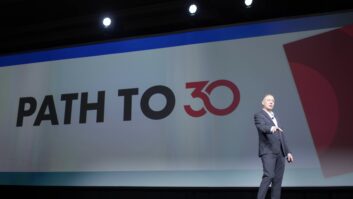NEW YORK —
Twelve years ago when
entered the CE business — carrying some major
brands that denied they had shipped the online retailer
— brick-and-mortar competitors saw it and all e-tailers
as the end of CE retailing as they knew it.
Well, in the dozen years since, plenty of brickand-
mortars got their own websites that do online
sales … which probably gave more
than a few a false sense of security.
Plenty more brick-and-mortars,
and late 1990s e-tailers,
are gone. Some expired due to
competition or lousy business
plans or, in recent years, the sour
economy.
But
has survived and
thrived in the CE business, making even
CE giants like Best Buy and Walmart turn
around and take notice, because it has continued to
innovate and get even closer to its customers, knowing
their wants and needs — and all without a storefront.
CE retailing has changed, with shopping online being
second nature to consumers now. Amazon can be
credited as starting the online shopping phenomenon,
and enhancing it incrementally with a vast selection of
products, ease of use, great prices, reliable shipping
… and no sales taxes, but more on that later.
The brainchild of founder Jeff Bezos has taken CE
retailing by storm, especially in the past 18 months.
The TWICE Top 100 CE Retailers Report showed
sales in calendar year 2010 growing an astronomical
72 percent to $7.9 billion, trailing only Best Buy,
Walmart and Apple, landing it in fourth place.
More recently, Amazon reported CE sales and other
general merchandise grew 67 percent in North America
during the second quarter, ended June 30, to $3.5
billion.
In a statement accompanying the financial, CEO
Bezos said low prices, expanding selection, fast delivery
and innovation are fueling “the fastest growth
we’ve seen in over a decade.”
Amazon’s CE sales were only enhanced during the
quarter due to innovations like the Kindle e-reader. The
company’s $139 3G version, with AT&T-sponsored
screensavers, is currently its best-selling model, Amazon
said.
If you talk to consumers, you’ll find out why. In a
TWICE Special Report on Amazon this summer (July
5, p. 20), we quoted a survey released by the Consumer
Electronics Association (CEA) and The Stevenson
Company’s TraQline shopper surveys.
Amazon’s share of total CE dollars
spent rose 27.5 percent over the
12-month period, ended March
31, to 5.1 percent, compared
with a 0.7 percent decline in
share for Best Buy and essentially
flat results for Walmart
during the same period.
The survey showed that driving
the traffic are price, selection and
shopping experience — the top motivations
of consumers for purchasing their electronics
where they do. Amazon was tops in all three areas.
And the survey indicated that the ability to shop any
brick-and-mortar — Best Buy, Walmart, Target — and
perform price comparisons with a smartphone app is
a dramatic new element in the battle for CE market
share, profitability and dominance.
Amazon is continuing to innovate. The online retailer
is optimizing its website for tablet PCs, according to
reports last month that were ripe with details of a supposed
new streamlined design that has a larger search
bar, fewer buttons, and positions digital content ahead
of physical merchandise on the home page.
All of this makes sense since tablets, along with
smartphones, are the two hottest CE products of
2011, and Amazon introduced its own tablet, the Kindle
Fire last week.
While many in the CE industry and even its key rivals
acknowledge Amazon’s savvy online innovations,
many see its refusal to collect and pay state sales taxes
nationwide as, at best, the key to its recent growth
spurt, and, at worst, a terribly unfair advantage.
In a statement issued to TWICE in late July when it
released its most recent quarterly financial, an Amazon
spokesperson said, “We collect sales tax or its
equivalent in more than half of the areas where we do
business, and our business is thriving in those areas.”
Still, Amazon has fought sales tax legislation in numerous
states, opting instead to back a national approach.
A long-anticipated plan to streamline state and local
tax collection on e-commerce sales was introduced
into the House and Senate during this past summer of
budget and deficit debacles in Washington. Passage
of the Democrat-backed legislation remains uncertain,
as do many other issues facing the nation.
The bill would certify the Streamlined Sales and Use
Tax Agreement, a comprehensive interstate system to
harmonize and simplify sales tax rules and administrative
requirements that has been adopted by 24 states,
but requires congressional approval under the Supreme
Court’s 1992 “Quill” decision.
Amazon supports the bill, along with plenty of retail
groups, including the National Retail Federation (NRF)
and the Retail Industry Leaders Association (RILA), as
well as individual retailers.
More recently, Amazon has agreed to begin collecting
sales tax in California in one year. But if national
legislation ever does get passed, CE retailing
rivals will find out how much of Amazon’s market clout
comes from its tax advantage and how much is due to
the innovations it has fostered in online retailing.












